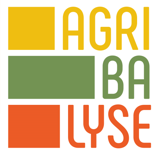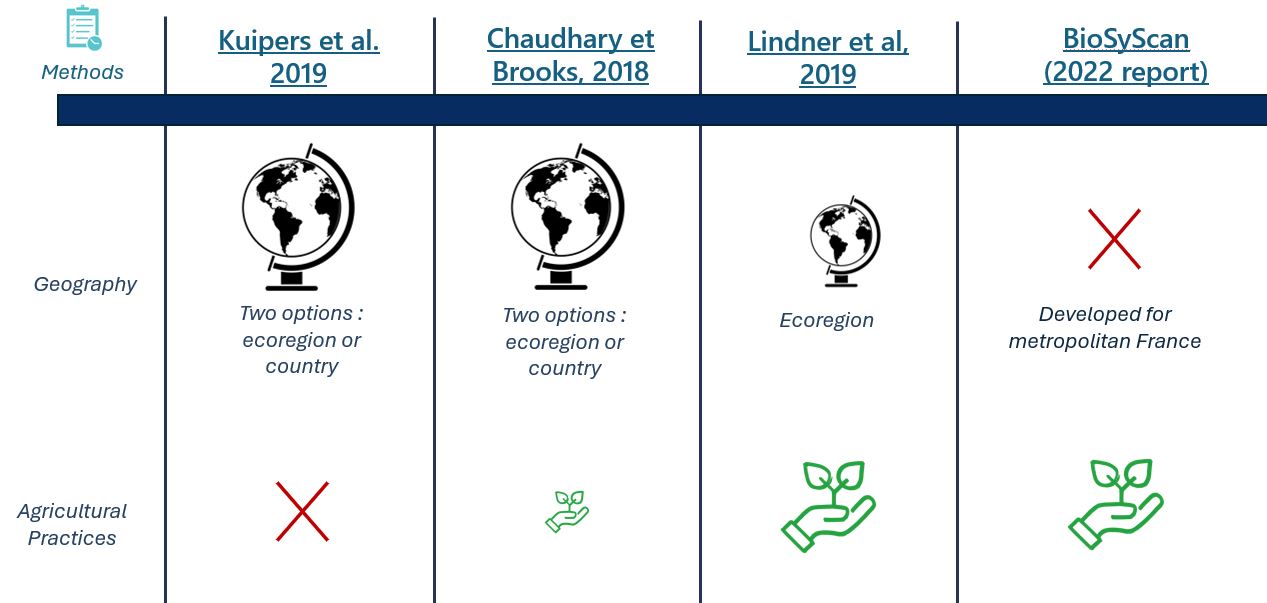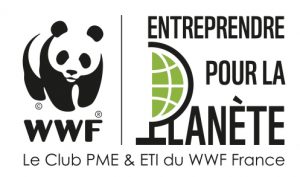Biodiversity in LCA for agricultural production.
What are the take-aways of our mission for ADEME and AGRIBALYSE ?

Context
In 2023, we carried out a comparative study of different methods for assessing biodiversity in the production of agricultural commodities. The aim of this assignment was to apply different methods to case studies, to reveal the strengths and limitations of each, as well as the contradictions that exist between them.
We have studied 4 methods.

What are the conclusions of this study? It depends on the question asked.
Let’s start with an important point: in general, in the food sector, the majority of the biodiversity footprint comes from the production of the raw material(s). This is also the case in other industries using agricultural raw materials, such as cosmetics and textiles.
If you work in these sectors, and your sourcing is international, then the first question that arises when it comes to biodiversity is where the raw materials come from.
What geographical origin of raw materials impacts biodiversity?
To answer this question, two methods are suitable: the Kuipers et al. (2019) and Chaudhary and Brooks, (2018) methods. They compare the « biodiversity » value of different origins, considering the number of species present in each country, their endemism, as well as the share of vulnerable species. The Caribbean islands (such as Haiti) and Madagascar are very rich in biodiversity, with species that are specific to these territories and do not exist elsewhere, and a substantial vulnerability of some of them. So, from a biodiversity point of view, we advise against sourcing agricultural raw materials from these countries.
For resources sourced from very large countries such as Brazil, China or the USA, it is necessary to identify more precisely in which regions the raw materials are produced. In the absence of information from your suppliers, the study enabled us to determine average biodiversity factors for each major commodity produced in each country (e.g.: corn produced by the USA comes essentially from the Midwest, Brazilian sugar cane essentially from the states of São Paulo and Goiás).
In the end, these two methods provide fairly broadly consistent conclusions. The future method adopted by the United Nations consensus (known as the GLAM consensus) should be a merged (and updated) version of these two methods.
How to foster good farming practices for biodiversity?
If, on the other hand, the geographical origin of agricultural raw materials is fixed, then the leverage of practices becomes a major factor in improving the biodiversity footprint of your products.
Two methods can be used to optimize practices with regard to the biodiversity footprint: the BVI method (Lindner et al., 2019) and the BioSyScan method (Dallaporta et al.), currently unpublished.
In both methods, the levers for improving biodiversity are similar: reduce chemical inputs (fertilizers and pesticides), reduce plot size, vary crops in space and time (by lengthening rotations), establish agro-ecological infrastructures (hedges, wetlands, riparian forests, etc.), reduce tillage. Improvements can be substantial per unit of surface area (biodiversity can be doubled on a ha); but accompanied by lower yields, there is a risk of a rebound effect where the surface area to be mobilized for the same quantity produced becomes greater. Generally speaking, these two methods tend to favor less intensive agriculture.
If impact is to be quantified per kg of product, we recommend BVI, which is compatible with other environmental indicators, such as climate change or pollution, which are reported per kg of product. We await the publication of BioSyscan. We hope that this more recent method, which has been developed and benchmarked for French agricultural production, will be extended to other countries, to eventually enrich the practice parameters currently used in BVI (Lindner et al. 2019).
How to balance geographical origin and farming practices at the same time for biodiversity?
Combined evaluations by simultaneously varying geographical parameters and practices are currently subject to debate. The method that seems to us, at this stage, the most promising for comparing these two aspects in a combined way is the BVI method (Lindner et al. 2019). Other methods, not studied in the ADEME project, also allow this combination, such as the PBF method.
Outlook
Biodiversity measurement tools are evolving rapidly, with a strong mobilization of the whole community: researchers, companies, public authorities. It is essential that the industry should also be able to test the various proposals, so that they can be better understood, operationalized and constructively challenged.
This is particularly true in a context where the measurement and reduction of impacts is now included in the regulatory corpus of the European CSRD (Corporate Sustainability Reporting Directive).
We support several businesses in this process. Do not hesitate to look out our offer and contact us.
Read more :
Read the report (in French) https://librairie.ademe.fr/6983-agribalyse-biodiversite-locale.html
References
Chaudhary, A., & Brooks, T. M. (2018). Land Use Intensity-Specific Global Characterization Factors to Assess Product Biodiversity Footprints. Environmental Science & Technology, April. https://doi.org/10.1021/acs.est.7b05570
Dallaporta, B., Bonnot, S., & Bockstaller, C. (2022). Predictive indicator of the impacts of agricultural systems on local biodiversity (BioSyScan v. 1.0). https://www.planet-score.org/public/uploads/2023/10/BIODIVERSITE-PRATIQUES-AGRICOLES-Methode-BioSyScan-v1.0-INRAe-ITAB.pdf
Kuipers K., Huijbrechts, M. A., Shippers, A. M., May, R, F., Graae, B., & Verones, F. (2019). Incorporating habitat fragmentation into the characterisation of land use impacts on biodiversity. SETAC Europe 29th annual meeting.
Lindner, J. P., Fehrenbach, H., Winter, L., Bischoff, M., Bloemer, J., & Knuepffer, E. (2019). Valuing Biodiversity in Life Cycle Impact Assessment. Sustainability, 11(20), 5628. https://doi.org/10.3390/su11205628
We offer solutions adapted to your ambitions
and resources
Would you like to find out about our latest studies or discover our new projects? Follow us on LinkedIn
![]() Member of the European PEF (Product Environmental Footprint) Technical Advisory Board
Member of the European PEF (Product Environmental Footprint) Technical Advisory Board
![]() Member of the French ADEME environmental labelling working group
Member of the French ADEME environmental labelling working group


